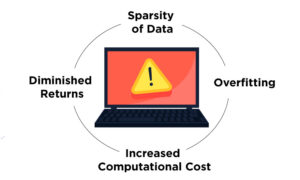In machine learning, the ‘curse of dimensionality’ is an important challenge that practitioners work on. The term is used to analyze and organize data in high-dimensional spaces. When the dimensions are increased then, the volume of the space is also increased, which makes data analysis more complex and less effective. In this blog, we explore the challenges that occurred due to the curse of dimensionality. Let’s understand practical solutions to conquer them.
What is Dimensionality?
In data science and machine learning, dimensionality means how many features or variables are present in a dataset. It can be 2D, 3D, or even more. Dimensionality helps us to understand complex data. It focuses on key factors. The more dimensions we use we get precise and exact information about a specific dataset. But sometimes this process becomes complex one to visualize and interpret the data.
For example, you are searching for dining out and put dimensions such as price, location, ambience, cuisine and many more.
What is the Curse of Dimensionality?
The increasing number of dimensions results in the ‘curse of dimensionality.’ It refers to the problems that occur while working with high-dimensional data. Here, the volume of the space increases, which makes data sparse, and thus, it complicates the analysis. It can lead to higher computing costs, make visualization harder, and create difficulties in making accurate predictions. Understanding this concept helps in deciding how many features to use during analysis to avoid these issues.
Challenges in Curse of Dimensionality
- Sparsity of Data: The amount of data required to maintain statistical presence increases with the growing number of dimensions in a dataset. In high-dimensional spaces, data points get scattered. This makes it difficult for algorithms to find the exact pattern.
- Overfitting: As the number of dimensions increases, the model becomes complex, and it starts to showcase random data instead of showcasing the true patterns. This results in overfitting, where a model works well on the training data but fails while working on new or unseen data. In high-dimensional spaces, this is a major issue.
- Increased Computational Cost: Working with high-dimensional data needs computing power and memory. The algorithms that work well in lower dimensions can become slow or may not work in higher dimensions. This leads to long training time and uses higher resources leading to high computational cost.
- Diminished Returns: Adding more features to a model doesn’t mean it will improve its performance every time, rather it will degrade the model’s accuracy.
Solutions to the Curse of Dimensionality
Although the curse of dimensionality poses serious challenges, there are effective strategies to reduce its effects. Here are some solutions that practitioners can use:
Feature Selection
Feature selection is the process of identifying and retaining relevant features of the dataset. It includes the following techniques, such as:
- Filter Methods: This method checks how important the features are while using statistical tests. For instance, correlating coefficients can help in identifying features of those variables that have a strong relationship with them.
- Wrapper Methods: These methods use a predictive model to evaluate feature subsets. They iteratively add or remove features to find the combination that yields the best performance.
- Embedded Methods: Embedded methods carry out feature selection under the model training process. Algorithms like Lasso regression help to reduce dimensionality by penalizing unnecessary features.
Dimensionality Reduction Techniques
These techniques change high-dimensional data into low-dimensional form by keeping important patterns in a complete form. Some popular methods include:
- Principal Component Analysis (PCA): PCA helps in finding the main directions (principal components) in data variations. It projects the data. This technique reduces dimensionality and preserves the informative part of the data.
- t-Distributed Stochastic Neighbor Embedding (t-SNE): It visualizes high-dimensional data and reduces dimensions while maintaining the relationships between data points. This makes complex datasets easier to visualize.
- Autoencoders: These are neural networks. They learn efficient representations of data by compressing the input data into a lower-dimensional form and then reconstruct it, further allowing for effective dimensionality reduction.
Regularization Techniques
These methods help to prevent overfitting and add penalties for complexity of data. Regularization techniques such as L1 (Lasso) and L2 (Ridge) are effective in high-dimensional settings. They encourage simpler models by constraining the model’s coefficients.
Ensemble Methods
This method works with various models and improves robustness and performance. It uses techniques such as Gradient Boosting and Random Forests that handle high-dimensional data better by combining predictions of several models, reducing the risk of overfitting.
Cross-Validation
It is a technique for evaluating the performance of models on unseen data. It divides the dataset into training and validation, which helps practitioners to understand how well their model generalizes, especially in high-dimensional settings.
Final Words!
The curse of dimensionality presents significant challenges in machine learning, but with the right strategies, practitioners can tackle these issues effectively. By using feature selection, dimensionality reduction techniques, regularization, ensemble methods, and cross-validation, data scientists can create robust models that perform well even in high-dimensional spaces. As machine learning continues to evolve, understanding and addressing the curse of dimensionality will remain vital for achieving accurate and reliable results.
To learn more about Dimensionality, explore us at HiTechNectar!
Read More: How Will the Internet Look Like by 2050?



